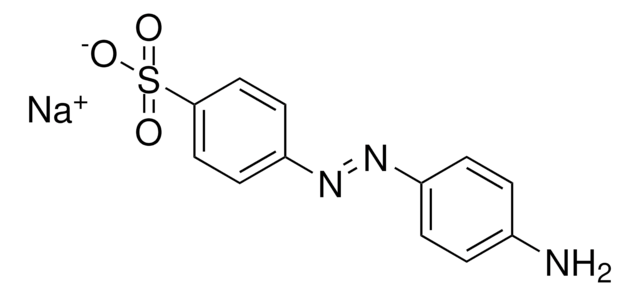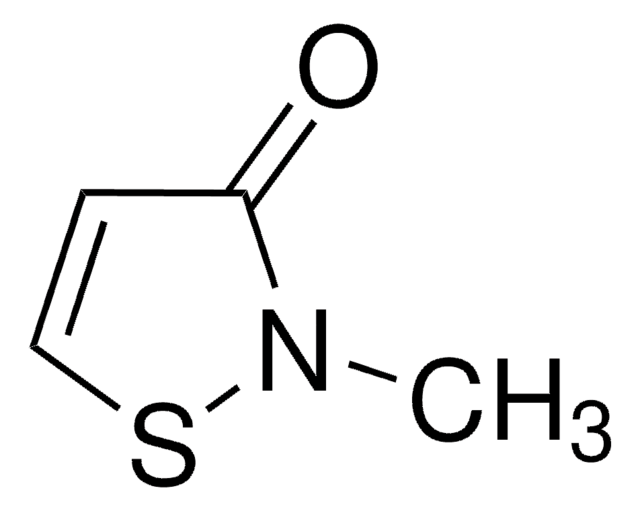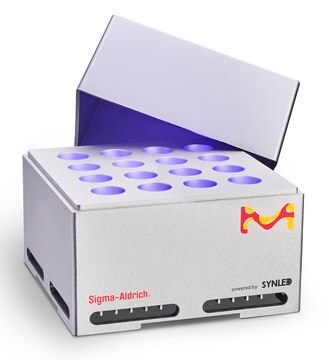919233
Sodium 2-(4-hexylphenyl)diazene-1-sulfonate
(0.5% solution in 25mM aqueous ammonium bicarbonate, pH 7.0), ≥95%
Synonim(y):
4-Hexylphenylazosulfonate, Azo
Zaloguj sięWyświetlanie cen organizacyjnych i kontraktowych
About This Item
Wzór empiryczny (zapis Hilla):
C12H17N2O3S · Na
Numer CAS:
Masa cząsteczkowa:
292.33
Kod UNSPSC:
12161503
NACRES:
NA.22
Polecane produkty
Poziom jakości
Próba
≥95%
Postać
liquid
współczynnik refrakcji
n/D 1.334
gęstość
0.994 g/mL
temp. przechowywania
2-8°C
Zastosowanie
4-Hexylphenylazosulfonate (Azo) is a photocleavable anionic surfactant developed by the Ge lab for use in high-throughput top-down and bottom-up proteomics by mass spectrometry (MS). Initially, the reagent showed a breakthrough as an improved method for top-down analysis [Brown et al. 2019]. Top-down analysis looks at intact proteins, while bottom-up analysis uses digested proteins. Of the two, top-down analysis is preferable for detecting post-translational modifications and sequence variations. Bottom-up is more commonly used and is likely to detect more proteins. This reagent was also shown to work for sample extraction that can be used for both top-down and bottom-up analysis on the same sample to maximize data collection[Brown et al. 2020].
Surfactants are required for protein extraction especially for challenging classes of protein including membrane proteins[Brown et al. 2020] and extracellular matrix proteins[Knott et al. 2020], but surfactants suppress the signal in MS. While removing a surfactant will improve the signal, this can cause protein loss and degradation. Azo allows for easy removal since it can be rapidly degraded using ultraviolet irradiation (λmax = 305 nm). Using Azo in this way reduces protein loss and gives an improved signal. Please see the Ge lab publications for information on using this product [Brown et al. 2019, Brown et al. 2020, Knott et al. 2020, and Aballo et al. 2021].
Product can be used with our line of photoreactors: Including Penn PhD (Z744035) & SynLED 2.0 (Z744080)
Surfactants are required for protein extraction especially for challenging classes of protein including membrane proteins[Brown et al. 2020] and extracellular matrix proteins[Knott et al. 2020], but surfactants suppress the signal in MS. While removing a surfactant will improve the signal, this can cause protein loss and degradation. Azo allows for easy removal since it can be rapidly degraded using ultraviolet irradiation (λmax = 305 nm). Using Azo in this way reduces protein loss and gives an improved signal. Please see the Ge lab publications for information on using this product [Brown et al. 2019, Brown et al. 2020, Knott et al. 2020, and Aballo et al. 2021].
Product can be used with our line of photoreactors: Including Penn PhD (Z744035) & SynLED 2.0 (Z744080)
Informacje prawne
PCT/US2019/035447
This page may contain text that has been machine translated.
Kod klasy składowania
10 - Combustible liquids
Klasa zagrożenia wodnego (WGK)
WGK 2
Wybierz jedną z najnowszych wersji:
Certyfikaty analizy (CoA)
Lot/Batch Number
Przepraszamy, ale COA dla tego produktu nie jest aktualnie dostępny online.
Proszę o kontakt, jeśli potrzebna jest pomoc Obsługa Klienta
Masz już ten produkt?
Dokumenty związane z niedawno zakupionymi produktami zostały zamieszczone w Bibliotece dokumentów.
Photocleavable Surfactant-Enabled Extracellular Matrix Proteomics.
Knott S J, et al.
Analytical Chemistry, 92(24), 15693-15698 (2020)
Kyle A Brown et al.
Nature methods, 16(5), 417-420 (2019-04-17)
We report the identification of a photocleavable anionic surfactant, 4-hexylphenylazosulfonate (Azo), which can be rapidly degraded by ultraviolet irradiation, for top-down proteomics. Azo can effectively solubilize proteins with performance comparable to that of sodium dodecyl sulfate (SDS) and is compatible
Nasz zespół naukowców ma doświadczenie we wszystkich obszarach badań, w tym w naukach przyrodniczych, materiałoznawstwie, syntezie chemicznej, chromatografii, analityce i wielu innych dziedzinach.
Skontaktuj się z zespołem ds. pomocy technicznej







